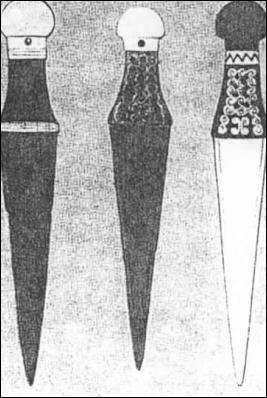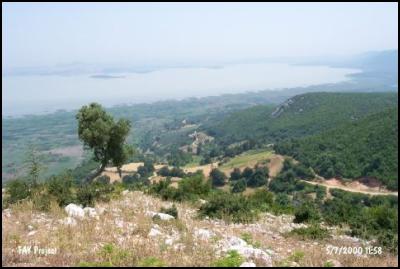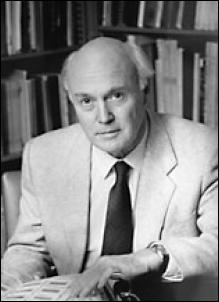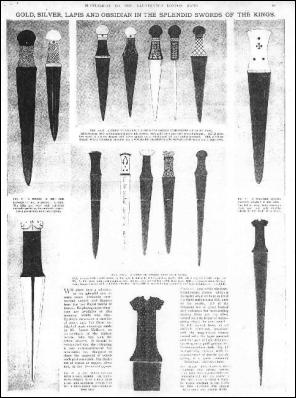Suzan Mazur: The Dorak Affair's Final Chapter
Is This The Dorak Affair's Final Chapter?
Archaeology Prof. David Stronach Discloses Jimmie Mellaart Dreamed Up The Dorak "Enterprise"
By Suzan Mazur

Yortan Daggers - Image ILLUSTRATED LONDON NEWS
Kenneth Pearson and Patricia Connor (Authors of The Dorak Affair), are two of a handful of people who have ever seen Jimmie Mellart's Dorak Treasure memoirs, here is what they said in their book:
"First of all we examined the typescript [over the last almost 50 years, the only other person to have seen the memoirs/monograph is Goddess and Bull author Michael Balter aside from Mellaart's closest colleagues at the British Institute of Archaeology, Ankara (BIAA)]. At a rough glance it was about 60,000 words long and recorded in a series of chapters the physical description and provenance of all the objects that were said to have come out of the two tombs. If this were a genuine document, the scholarship was impressive."For page after page, it analysed and synthesised every aspect of the excavation. There was not a detail that did not appear to make sense in the context of the book's thesis. It contained, moreover, one chapter that had been written by another hand [emphasis added]. This had been compiled by the colleague of Mellaart who, that winter of 1958 in Ankara, had helped the archaeologist to sort the material into some sort of order before it was presented to Seton Lloyd for the first time.
Advertisement - scroll to continue reading"This chapter [on metallurgy], too, fitted neatly into the story Mellaart was trying to tell and in every way was consistent with the narrative. The typescript had remained in that box ever since its completion, when Mellaart's superiors [at BIAA] had declined to assist its publication until its author could produce photographic evidence to substantiate his claims. And this, as everyone well knew, had never been forthcoming.
"But if there were no photographs to back the discovery, the sketches in that box seemed to suggest contact with a unique find. The care with which they were drawn was astonishing. On sheets of thin paper, some of it cut from the Ankara Institute's notepaper, Mellaart had pencilled jewelled dagger handles, every gem of which appeared to be exactly in place.
There were drawings of an ancient comb with a dolphin motif, of jewel boxes again decorated with dolphins, of a vase in the shape of a bird of gold and silver; there were sketches of the gold leaf covering which was said to have extended over the surface of the wooden throne which could have been a present from Egypt, details of the rug which had disintegrated when the tombs had been opened, and even rubbings of the sword blade etched with ships and of a sherd of alabaster which had been marked with hieroglyphics.
And every one of these drawings had been annotated in Mellaart's hand. Written on these sheets and arrowed to the appropriate spots were words and phrases like 'hilt of iron sword', 'crystal', 'extremely like other head', 'length 76 cm', and 'edge of scratch break here'. If Mellaart had done this work at the house in Izmir [Anna Papastrati's place], there is every chance that he could not have left the premises if he hoped to complete his task under the continual threat that the girl might suddenly get cold feet."
The Dorak mystery flower has opened at last. Earlier this week in phone conversations I had with David Stronach, Professor of Near East Archaeology at the University of California - Berkeley, Stronach disclosed that Jimmie Mellaart invented Dorak. He called it a "dream-like epsidode".
Stronach is a former British Institute of Archaeology, Ankara (BIAA) colleague of Jimmie Mellaart - the celebrated digger who found what many consider the world's oldest urban civilization at Catalhoyuk along with archaeologists David French and Allan Hall, but is best known for dazzling the world with drawings of his Dorak treasure in The Illustrated London News.
Scoop
has already published two reports on the Dorak mystery
see:
Mazur: Getting To The Bottom Of The Dorak
Affair
& Dorak Diggers Weigh In On Anna & Royal
Treasure

photo of actual Dorak Village – source TAY-Foto
At the time of the creation of the Dorak story, Stronach was a scholar at both BIAA and the British School of Archaeology in Iraq.
But most important of all in relation to the Dorak mystery, Stronach's was the other handwriting Pearson & Connor refer to above in Mellart's memoirs .
A year or so after the Dorak affair, Stronach moved on to become director of the British Insitute of Persian Studies in Tehran, where he stayed for twenty years, even after the fall of the Pahlavi regime.
Like the Mellaarts, Stronach was also a friend of mystery writer Agatha Christie and often accompanied her shopping in the Baghdad bazaars. Christie's husband was archaeologist Max Mallowan, who served as president of the British Institute of Persian Studies during the years Stronach was director.

David Stronach, Professor of Near East Archaeology at the University of California - Berkeley
Stronach has conducted numerous excavations -- in Turkey (at Hacilar with Mellaart), Iraq and Iran. Last year he received the Archaeological Institute of America's Gold Medal for Distinguished Archaeological Achievement. (See… David Stronach: The Spearhead for the Institute) .
David Stronach told me the following about Jimmie Mellaart and Dorak:
Stronach: In the end I had some doubts about the whole [Royal Treasure of Dorak] enterprise.
Mazur: Was Mellaart's Dorak affair some kind of dream?
Stronach: That's a very nice way of putting it - a dream-like episode.
Mazur: But Mellaart continues to say Dorak is "fact". Someone of his particular brilliance finds it difficult to acknowledge that his dream is not real?
Stronach: Yes. . . .
Mazur: Pearson & Conner in Dorak Affair quote late BIAA director Seton Lloyd saying you helped to draw some of the artifacts.
Seton Lloyd: "Jimmie told me he had something important to explain, but for several days the two of them [Jimmie & David Stronach] acted like excited kids, scribbling away on bits of paper making sketches."
And Michael Balter has emailed me saying you wrote Mellart's metallurgy chapter for his monograph.
Stronach: I wrote part of the chapter on metallurgy.

Click for big version
image ILLUSTRATED LONDON NEWS
[Stronach refers me to his Anatolian Studies writings from 1957 and says he was brought into the Dorak picture because of his expertise on metals.]
Stronach: You have to remember that Jimmie was the most famous archaeologist in the world at the time! And I believed him. I still have great affection for him.

". . . indeed it is in vessels like these that we can imagine the legendary Argonauts sailing through the Sea of Marmora, past Dorak, on the way to Colchis." - image ILLUSTRATED LONDON NEWS
Stronach: He [Mellaart] was copying genuine copper daggers of the "Yortan type" that exist in Turkish museums. The dagger drawings were Jimmie's. Rubbings made by running your pencil around the metal dagger.
Jimmie wasn't an artist. The exotica - the figurines he couldn't capture -- they were drawn by Hydie [Mrs. Seton] Lloyd, who was more artistic.
And so ends one of the great antiquities mysteries.
I'd again like to acknowledge the contribution of Turkish journalist Ozgen Acar, who first introduced me to Dorak and provided essential clues and contacts. He also taught me much of what I know about Anatolia's ancient art. During the years Ozgen was reporting from New York, I never left his office without a collection of antiquities catalogues. He is now putting the finishing touches on a real masterpiece, a thousand-page book on Turkey's ancient theaters.
And Happy 80th Birthday Jimmie Mellaart! You are loved even without the Dorak Treasure.
Suzan Mazur's stories on art and archaeology have been published in The Economist, Financial Times, Connoisseur, Archaeology (cover) and Newsday. Some of her other reports have appeared on PBS, CBC and MBC. She has been a guest on McLaughlin, Charlie Rose and various Fox television news programs. Email: sznmzr@aol.com


 The Conversation: News Bargaining Incentive:
The Conversation: News Bargaining Incentive: Binoy Kampmark: Last Acts -Time For Biden To Pardon Assange
Binoy Kampmark: Last Acts -Time For Biden To Pardon Assange Binoy Kampmark: Foiling Rupert Murdoch - Project Harmony Misfires
Binoy Kampmark: Foiling Rupert Murdoch - Project Harmony Misfires Ian Powell: Commissioner’s Approach To Healthcare Provision - ‘Slash And Burn’
Ian Powell: Commissioner’s Approach To Healthcare Provision - ‘Slash And Burn’ Jack Yan: The Case For Brand Aotearoa
Jack Yan: The Case For Brand Aotearoa Ramzy Baroud: Unity Above Else - The Only Road to the Liberation of Palestine
Ramzy Baroud: Unity Above Else - The Only Road to the Liberation of Palestine